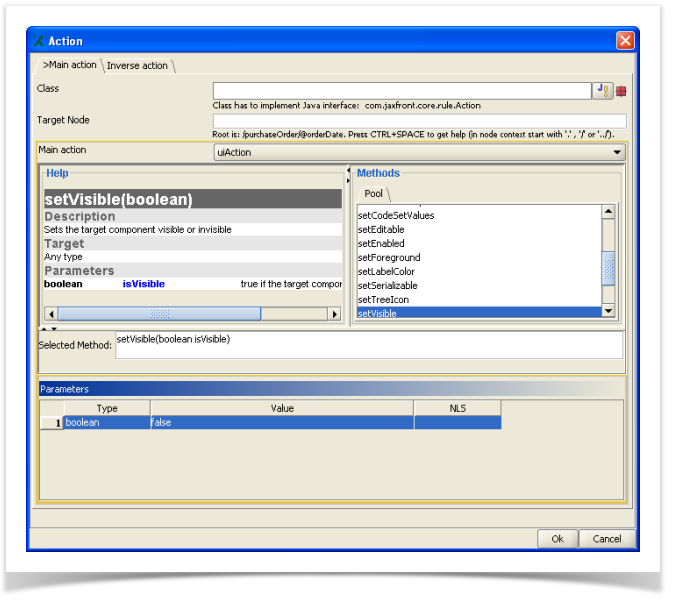An action defines a change of the model or the user interface (visual event).
XUI component - Actions
The actions are sequentially released if the condition was positive on examination.
XUI component - Main Action
Fieldname | Default | Description |
|---|---|---|
| Is enabled | true | If set to No the action is ignored! |
Class |
| With the indication of its own Java class, the condition can be implemented. The class must implement the Action interface. If a standard GUI action or a change of model is indicated, in combination with its own class, both actions are implemented. The own action implementation is executed last. |
Target Node |
| Every action requires the indication of a target node, respectively target component. If no target is indicated, the action is executed on the node of the rule definition. |
| Address only serialiyable nodes! | false | Action |
| Description | A freetext description of the action | |
Main action |
| Determines the kind of the action: Property change action -> formula result will be set to all target nodes! |
Formula expression |
| Defines the value to be set at the target node. Note: Thereby the target node must be a leaf (simple type). |
If the target of an action refers to a component, which is represented by a Plugin, you can call all visible methods, which define a combination of the permitted parameter values (see Supported parameter types). The methods may be called over the Java Reflection API. The GUI action causes a visual change in the user interface.
XUI component - GUI Action
You can double-click one of the specified Methods to select it and list its parameter values. See 1 in the above Figure. . Then, you can define a suitable value for each parameter. See 2, in the above Figure.
If a parameter is of the type „String", you can enter a text for the language-dependent translation., into the „NLS" field
Table of all standard GUI actions.
Name | Description |
|---|---|
addTreeNode | Inserts the target node as a new tree entry. |
Boolean | Defines whether the inserted node is to be serialized or not. |
jumpTo | Jumps to any target node and brings its visualizer to the front. |
removeHint | Removes a previously inserted reference to the target node. |
removeMessage | Removes a previously introduced message for the target node. |
removeTreeNode | Removes a previously imported tree entry for the target node. |
Boolean | Defines whether the node, which is being removed, is to be serialized or not. . |
setApplicationRequired | Sets the target node to be mandatory or optional, for the application. This changes the background color of the addressed input element. |
Boolean | Defines whether the target node is mandatory (true) or optional (false). |
setBackground | Defines the background color for the target input element. |
Color | RGB color value (e.g. 210,220,120) |
setChoosenKeyContextValue | Sets any context data relative to the referred context (provided XPath) of a Key-KeyRef relationship. |
String | XPath expression relative to the current context of the target node and its Key-KeyRef relationship. |
String | Value to be newly set. |
setCodeSetValues | Sets a number of CodeSet values on the target node. |
String | URL of the CodeSet. |
String | Name of the CodeSet. |
String[] | Codes to be set for the new selection (comma separated). |
String | Default selection value. |
setEditable | Make the target editable or not. |
setEnabled | Locks or unlocks the input element of the target node. |
Boolean | Lock or unlock. |
setForeground | Sets the text color for the input element of the target node. |
Color | RGB color value (e.g. 210,220,120) |
setLabelColor | Sets the label color for the target input element. |
Color | RGB color value (e.g. 210,220,120 |
setSerializable | Defines whether the target node is to be serialized or not. |
Boolean | Should the target node be serialzed or not. |
setTreeIcon | Defines the icon for the tree entry of the target node. |
String | Icon name of the tree entry (gif or jpg). Thereby, you can define the entire path indication or the icon name alone (resolution via class path). |
setVisible | Defines whether the target input element is to be indicated or not. |
Boolean | Should the target element be displayed or not. |
setVisibleAndSerialize | Defines whether the target input element should be displayed respectively serialized or not. |
Boolean | Should target element be displayed or not. |
Boolean | Should target node be serialized or not. |
showHint | Displays a dynamic reference on the target element. |
String* | Reference text. |
Boolean | Defines whether the reference text concerns a formula or not. |
Color | RGB color value of the dynamic reference. |
Boolean | Defines whether the reference text should be displayed in bold font. |
showLabel | Controls the visibility of the target input label. |
Boolean | Defines whether the label is visible or not. |
showMessage | Displays a message, which is freely selectable for the target node. |
String* | Text of the message. |
String | Classification of the message („error", „incomplete",„info",„warning",„hint", or „question") |
Boolean | Defines whether the message is displayed as a dialog (true) or added to the error list (false). |
Boolean | Defines whether the end user should confirm the message, so that it disappears. |
* When these values are indicated, the text can be translated. .

